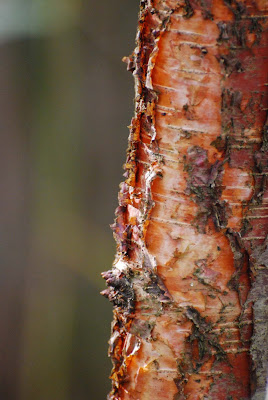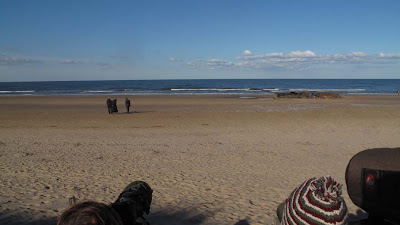Well, I seem to be apologising quite a bit recently for not keeping up with my blog posts. So, I'm sorry this has taken so long to get here. I think I've fallen off the edge of the blogging world at the moment! Here are some 'odds and ends' photos from my trip to Norfolk back in October. We were staying at a small town called Hunstanton on the North Norfolk coast. This is just about the only place along the coast in this part of the country that has cliffs.
 We spent one day birding inland at a place called Sculthorpe. It's a nature reserve run by the Hawk and Owl Trust which has a mix of deciduous woodland and reedbeds.
We spent one day birding inland at a place called Sculthorpe. It's a nature reserve run by the Hawk and Owl Trust which has a mix of deciduous woodland and reedbeds. I didn't get many photos of birds here, but found some other things to point my camera at! Below, some lovely peeling birch bark.
I didn't get many photos of birds here, but found some other things to point my camera at! Below, some lovely peeling birch bark. Common Darters are one of the latest flying of our Dragonflies. Here is a male basking in some sunshine on the broadwalk railings.
Common Darters are one of the latest flying of our Dragonflies. Here is a male basking in some sunshine on the broadwalk railings. And the female doing the same not far away.
And the female doing the same not far away. There are some nice fungi in the wood here. I took a couple of photos of ones I could see from the broadwalk.
There are some nice fungi in the wood here. I took a couple of photos of ones I could see from the broadwalk.
 From one of the hides, we waited patiently for this shy Water Rail to emerge from the reeds to feed on dropped seeds from the feeders above.
From one of the hides, we waited patiently for this shy Water Rail to emerge from the reeds to feed on dropped seeds from the feeders above. A windmill at Waxham on the east coast side of this large county.
A windmill at Waxham on the east coast side of this large county. One day we were lucky to be in the right place at the right time to experience a flock of 30 Bohemian Waxwings. It was right at the end of the day though so unfortunately the light was absolutely terrible for photography. However, it was lovely to stand just a few yards away from these beautiful birds as they communicated to one another with their amazing trilling call.
One day we were lucky to be in the right place at the right time to experience a flock of 30 Bohemian Waxwings. It was right at the end of the day though so unfortunately the light was absolutely terrible for photography. However, it was lovely to stand just a few yards away from these beautiful birds as they communicated to one another with their amazing trilling call.









































